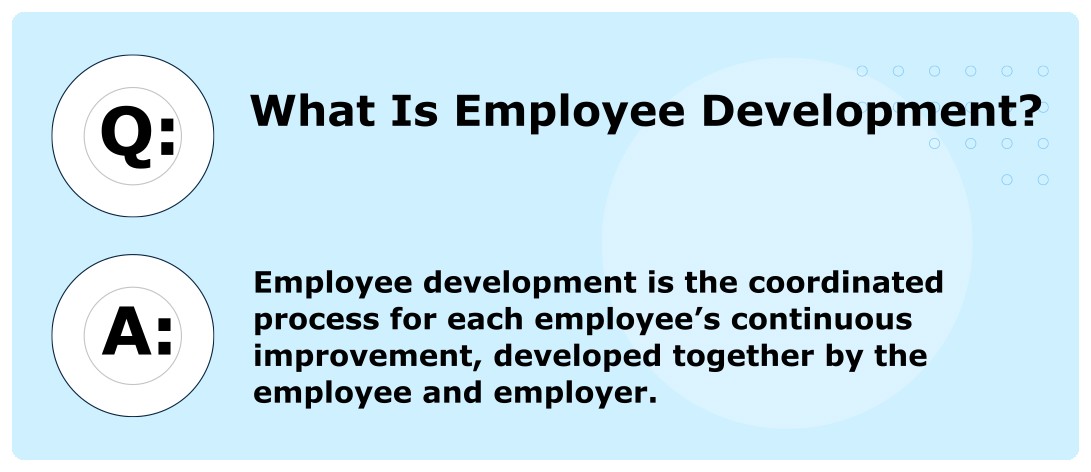
When it comes to an individual’s development and training approaches, there’s no one-size fits all. Many other variables play a role in each employee’s personal development aspirations and plan. Why does the employee want to grow in a certain direction? What improvements or now skills does the employer want or need from the employee? Is the purpose of the development to grow skills, increase employee motivation, or both? You can already see the need for compromise and communication, which is why so many turn to outsourced HR providers as mediators and strategists.
The employee development process will depend on what goals the employee has at the outset. From there, employees can take any number of different approaches to improve their skills and increase their knowledge.
What Is Employee Development?

Why is Employee Development Important?
Businesses and people are never static—at least not the ones who want to remain successful. Instead, they maintain a dynamic presence in the market and they create a dynamic environment for their own growth. At a business, this includes enabling growth for employees, encouraging them to develop and try new things.
A company culture that promotes employee involvement sees employees chase new roles and challenges, interact with clients, head projects, and take on leadership positions. Employee development is important because it changes the attitude of the employees about the business. Below are some more of the tangible benefits:
- Employee-driven technological development and adaptation.
- Turns static positions into dynamic roles.
- Develops confidence in employees.
- Reduces overall turnover, increases tenure and promotions
- Employees become more engaged, their morale improves.
- Increases upward mobility of employees.
- Improves company reputation (internal and external), attracts talent.
- Developing “soft skills” improves teamwork and employee interaction.
- Quick response to industry and market changes.
- Increases productivity without pressure, which improves retention.
What is Employee Development in HRM?
One of the main roles of human resource management (HRM) is to monitor and improve the wellness and aptitude of an organization’s workforce. To do this, HR providers use different approaches to employee development.
There are four main types of employee development: formal education, assessment, job experience, interpersonal relationships.
Formal Education – More education and formalized training can be beneficial to the employee’s skill set. But more important than advanced skills is gaining an outside perspective to apply to their current role. Employees can achieve a degree or certification that makes them more valuable in and excited about their role.
Assessment – Assessment helps employees know where they stand in terms of their strengths and weaknesses. This includes how well they fulfill current responsibilities and meet expectations, as well as their path forward. Assessment can feel like receiving a report card, but, when done correctly, it acts as a way to track, monitor, and encourage growth.
Interpersonal Relationships – Mentorship and coaching, cross-training, peer review, and workshops are all interpersonal relationship strategies that allow employees to help each other thrive.
Job Experiences – How often do your employees have the opportunity to work in a different department, tackle a different type of project, or lead a presentation for the first time? Job experiences are a pragmatic approach you can do on a daily basis with employees.
Best Practices for Implementing Employee Development Programs
Navigating the vast landscape of employee development can be daunting. Yet, the art of crafting a program that resonates with every employee lies in a handful of tried-and-true practices. Here’s how you can set the stage for a program that’s as engaging as it is transformative:
- Tailored Learning Paths: Recognize that each employee’s growth trajectory is unique. Develop personalized learning plans that align with their aspirations and the organization’s goals. This bespoke approach not only fosters personal growth but also drives engagement and productivity.
- Diverse Learning Formats: From interactive workshops to e-learning modules, variety is key. Incorporating different formats caters to varied learning preferences, ensuring everyone finds a medium that resonates with them.
- Continuous Feedback Loop: Construct a culture where feedback is not a once-a-year event but a continuous dialogue. Regular check-ins and constructive feedback help steer the employee’s development journey in the right direction.
- Leadership Involvement: Encourage leaders to be actively involved in mentoring and coaching. Their firsthand experience and insights are invaluable for employees aiming to navigate their career paths.
- Measure Success: Define clear metrics to gauge the effectiveness of your development programs. Whether it’s through employee satisfaction surveys, performance metrics, or promotion rates, tracking progress ensures your programs are delivering real value.
Challenges in Employee Development
As with any organizational initiative, employee development programs face their fair share of challenges. Here’s how to navigate these waters with finesse:
- Resource Allocation: Often, organizations struggle to allocate sufficient time, budget, and personnel to development programs. Prioritizing these resources is crucial, as the benefits—enhanced skills, better engagement, and retention—far outweigh the initial investment.
- Identifying Individual Needs: Not every employee knows what their development path looks like. It requires a keen eye and active engagement from managers to identify and nurture their growth aspirations.
- Keeping Up With Industry Changes: The rapid pace of industry evolution means that what’s relevant today might be obsolete tomorrow. Ensuring your programs are up-to-date requires constant vigilance and adaptability.
- Engagement and Motivation: Simply offering development opportunities isn’t enough; employees must be motivated to take advantage. Creating a culture that values growth and provides time for learning is essential.
By understanding these challenges and implementing best practices, you can create a robust employee development program that not only addresses individual aspirations but also aligns with your organization’s strategic goals. Such a program not only cultivates a culture of continuous improvement but also positions your organization as a beacon of growth and opportunity in the eyes of current and prospective employees.
What are the Approaches to Employee Development?
There are many different approaches to and types of employee development. Deciding which to focus on depends on what goals the individual and employer have: what’s the reason behind the additional training? This process involves steps like:
- Identifying the goals and objectives of the business and the employee’s position.
- Making an assessment of the employees skills, responsibilities, and potential.
- Determining goals, benchmarks, and milestones the employee can pursue.
- Developing a timeline or schedule for additional training.
How Do Companies Develop Their Employees? They Rely On Experts.
Determining the best strategy for employee development can be a difficult process for businesses to navigate themselves. These decisions are based on the individual employee, the business need(s), and the resources available. Where to start? That’s when a third party moderator comes into play. HR outsourcing provides an outside perspective, supported by expert background in employee development, to create a personalized strategy for your business.
At Milestone, we understand the importance of working alongside your business and human resource department to create opportunities for employee development. We have a wealth of knowledge and ideas to help your employees feel comfortable taking steps towards growing who they are as an employee of your business.
Want to learn more about our employee development program consulting services? Contact us today and start a conversation that could lead to impactful change in your business.
Related Content

Drivers of Employee Engagement
Unhappy and disengaged employees can cause chaos in a business. Productivity will suffer, goals won’t be met, turnover costs ...

What are the 5 main areas of HR
Smart founders recognize that there is simply one component of their business that they could not exist without: their people. ...

Startup Employee Benefits – Compensation and Health Benefits for Startup Companies
At its core, your startup or small business should include the following benefits: Health Insurance (vision and dental), paid time ...
Stay in the know